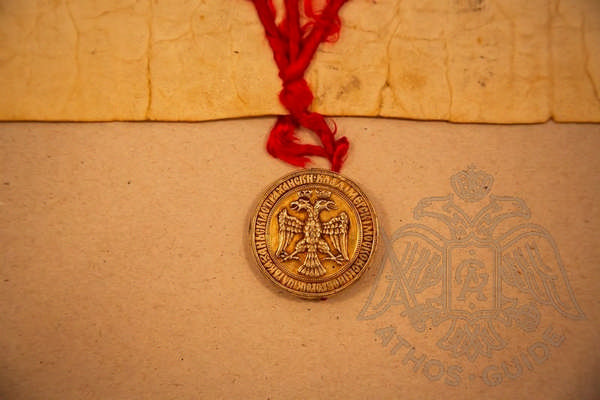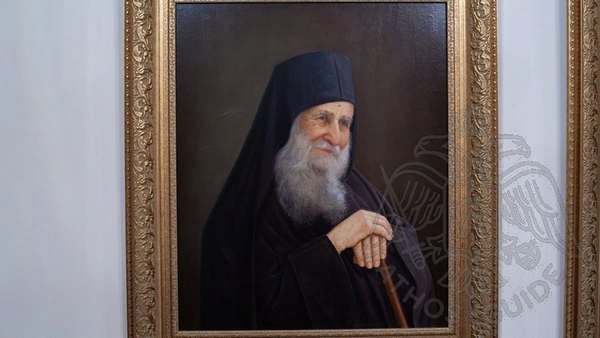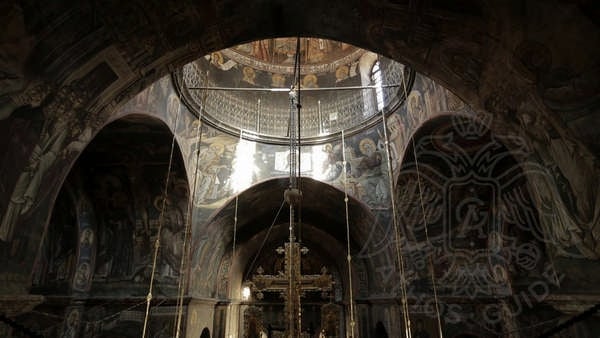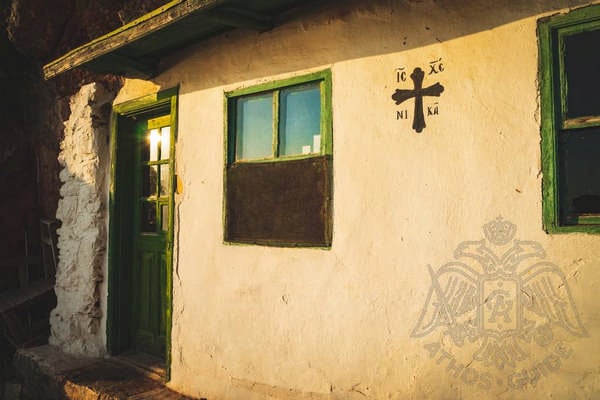The History and the Myths Regarding Mount Athos

During the long presence of the Athonite state in the peninsula of Chalkidiki, there was the need to compose a chronicle of its foundation and development. Such writings appeared for the first time during the early 14th century. As the years passed by, it became increasingly difficult to reconstruct the course of history and the sequence of events. The gaps were filled with speculations and invented stories that were far from reality.
The monasteries searched for the date of their foundation in as earlier times as possible. The Karakallou Monastery was thus associated with the name of the Roman Emperor Caracalla, despite the fact that the latter was a pagan. The Vatopedi Monastery, according to the first version, took its name from the morphology of its terrain. The word “vatopedi” was considered to be a reference to the “plain of brambles” where the monastery is located (in Greek “πεδιάδα με βάτα” and consequently “Βατο-πέδι”). However, according to another version, the word “vatopedi” came from the word “child” (in Greek “παιδί” and consequently “Βατο-παίδι”). Among the monks, it was very popular the narrative of the rescue of the son of the emperor Theodosius I in the area of brambles. The Holy Monastery of Stavronikita was originally pronounced as the Monastery of Stravonikita. However, as this name was not pleasant to the ear and adequate to a holy place, it was changed, making a reference to the Holy Cross (“σταυρός” – “Stavros”). Finally, the unknown Kastamonite ceded his position to the Emperor of Constantinople and, thus, the Kastamonite Monastery became the Konstamonitou Monastery.
In general, the attribution of names is often associated with the imperial family and the events that influenced the history of Athos during the Byzantine era. Thus, individual narratives are related, for example, to the foundation of the monastery by Constantine the Great, to the destruction suffered under the rule of the emperor Julian, to the restoration under Theodosius I, etc. Another important period of massive devastation is the era of iconoclasm.
The development of monasticism in Athos is considered to be the result of the actions of Bishop Clement, who came from Jerusalem with the aim of establishing a monastic community. A study of the history of the imperial houses of Constantinople reveals the intense activity of the monarchs, who founded a large number of monasteries both in the Byzantine capital and on the distant peninsula of Athos.
 As far as the legends of the Athonite state are concerned, many of them are linked to the “avaton” of Mount Athos, the prohibition of women to enter the peninsula. According to tradition, the Virgin Mary, together with the Evangelist John, found themselves on the peninsula after a violent storm forced them to dock on the Athonite coast. The Virgin Mary, feeling delighted by the beauty of the place, asked her Son to give her the land as a gift. Since then, Mount Athos has been the garden of Theotokos, who is the only woman of the athonite state.
As far as the legends of the Athonite state are concerned, many of them are linked to the “avaton” of Mount Athos, the prohibition of women to enter the peninsula. According to tradition, the Virgin Mary, together with the Evangelist John, found themselves on the peninsula after a violent storm forced them to dock on the Athonite coast. The Virgin Mary, feeling delighted by the beauty of the place, asked her Son to give her the land as a gift. Since then, Mount Athos has been the garden of Theotokos, who is the only woman of the athonite state.
The Appearance of the First Monks
By the end of the 3rd century, there was a strong tendency to withdraw from secular society. With the prevalence of settlement in more deserted areas, there was created the foundation of the Christian monasticism.
The way of life of the monks, which appeared within the Church from the earliest period of its formation, was opposed to the social organization of the secular state. Monks, concentrated on their personal relationship with God, denied all the individual aspects of a secular life. The only thing that became meaningful was the salvation of their soul, while material goods lost their value. Whoever wished to stand before God, should have fought hard against the temptations of the external world. After all, as Christ Himself said, whoever wants to follow Him must take up their cross.
The above principles of high morality formed the foundation of the life of the early Christians, who wished to lead a highly ascetic and austere life of fasting and prayer, denying all the benefits of human civilization.
In the middle of the 3rd century and, especially, during the early 4th century, when persecution against Christians became more intense, many were forced to leave the cities. Even with the cessation of persecution, however, the number of hermitages continued to grow. Retreating to inaccessible areas, Christians devoted themselves to the struggle against temptations.
Ascetics began to seek out more and more remote places. The further away they lived, the more respect they inspired. The first monk of the desert is considered to be Saint Anthony the Great (251-356), whose life was recorded with great care and love by Athanasius the Great. Living in the desert for more than 70 years, he earned the respect of both rulers and common people. Furthermore, he was an example for the ascetics of Egypt and other parts of the Middle East.
The monasticism he proposed contrasted with the more centralized organization developed by Saint Pachomius the Great (292-346) in Upper Egypt. The latter defined all aspects of the monks' life, such as their accommodation, clothing, diet and work. It was at this time that female monasticism appeared.
Saint Makarios of Egypt and Anthony the Great formed the first ascetic communities. The monks lived in cells remote from each other. Each community had an elder. The center of life was the temple, where they always gathered on Saturday evening, celebrated overnight and morning Divine Liturgies. This was followed by a common meal. The temple was usually located in the center of the residential area, at a crossroads, which also served as a market. Four such monastic communities were formed in the region of Egypt and took the name "sketes".
During the first thirty years of the 4th century, the system of organization of the monastic communities was consolidated. A few decades later, thanks to Basil the Great, a new way of constituting monasteries emerged. The Saint, having started his journey from the desert regions of Pontus, managed to bring their way of life to urban centers, arguing that man is a "domesticated and social animal, not a lonely and wild one" and that nothing suits his nature better than companionship. He thus introduced a communitarian way of organizing monasteries, charitable institutions, orphanages and schools, which was not, however, suitable for hermit monks.
The Early Periods of the Athonite Monasticism
Monasticism spread rapidly beyond the borders of Egypt, from the shores of the Mediterranean to Northern Europe. By the 4th century it had already spread to Thrace and a century later had reached Epirus.
In Macedonia it is estimated that monasticism began to develop during the same period. At the beginning of Maximian’s great persecution in 303, three women from Thessaloniki left their homeland, family and wealth, wanting to devote themselves to God and the spiritual goods of his heavenly kingdom. Although they were arrested and became martyrs, their story is one of the many examples of people who gave up the secular lifestyle. The mountain to which these three women, as well as other Christians, retreated is probably Chortiatis, located just outside the city of Thessaloniki.
 In Athos the Christian faith must have become quite well known from an early time. The inhabitants of the area were Christians as early as the 4th century. The peaks and slopes of Mount Athos were suitable for ascetics. The lack of references to the athonite monasticism of that period can be explained by the conditions of strict isolation and the particular modesty of the faithful. The period from 400 to 800 AD remains unexplored, since there are not enough sources referring to the development of monasticism and Christian communities.
In Athos the Christian faith must have become quite well known from an early time. The inhabitants of the area were Christians as early as the 4th century. The peaks and slopes of Mount Athos were suitable for ascetics. The lack of references to the athonite monasticism of that period can be explained by the conditions of strict isolation and the particular modesty of the faithful. The period from 400 to 800 AD remains unexplored, since there are not enough sources referring to the development of monasticism and Christian communities.
The early stage of the development of monasticism in Mount Athos is attested through a phrase in the sigil of Leo the Wise, concerning the so-called "elders of the ancient pulpit". Reference to the elders of Mount Athos is also found in the Typikon of the Emperor Tsimiski, where it is stated that people from the surrounding areas could enter the land of Athos only in the event of an enemy invasion and "with the general permission of the elders".
The Desolation of Athos
The way in which some of the oldest cities of Athos became deserted and disappeared remains unclear. The first interpretation attributed this fact to the Slavic invasions of the 5th century. However, this possibility is now considered unlikely, since, according to more recent studies, the Slavic invasion of Macedonia dates back to the 7th century. Moreover, there is no information on relevant invasions on the peninsula of Chalkidiki.
The most likely interpretation points to the desolation as a result of a 7th century pirate attack. Although the monks were not of much interest to the invaders, as they lived in isolation in small huts and cells, all the population of the nearby villages moved to safer areas. When external pressures were added to the internal threats of the iconoclastic period, the See of the Elders was dissolved and Athos was completely desolated.
The Formation of Monasticism
 In 843, representatives of the athonite community were present at the Council of Constantinople. During the same period, two of the most important personalities of Mount Athos appeared, Saint Peter the Athonite and Saint Euthymius the Younger.
In 843, representatives of the athonite community were present at the Council of Constantinople. During the same period, two of the most important personalities of Mount Athos appeared, Saint Peter the Athonite and Saint Euthymius the Younger.
Saint Peter served in the imperial army and was taken as hostage by the Arabs. After his miraculous release, with the help of Saint Simeon, at the command of Saint Nicholas, he traveled to Rome, where he became a monk. Returning from Rome to his homeland, Divine Providence brought Saint Peter to Mount Athos, where he lived for the next 53 years, until his burial in the cave where he resided. He survived by eating roots and herbs, while his beard reached his feet, like the beard of Saint Onoufrios. During these years he met no human being. It was only in his 53rd year that he met a hunter, whom he influenced deeply by his example, so that he became a monk himself. When the hunter returned to the cave, accompanied by two monks, he found that the old man had passed away. His remains were placed in the monastery of Saint Clement, in the same place where today we find the Holy Monastery of Iviron. The Life of Saint Peter the Athonite, compiled by Saint Gregory Palamas in the 14th century, describes the miracles that the Saint performed in Thrace. His arrival and life in Athos dates from 780 to 833.
Saint Euthymius the Younger was born in Asia Minor in 824. At the age of 18 he settled in a monastery on Mount Olympus and 18 years later, in 859, he arrived in Mount Athos. His name is closely associated with the monk Joseph, with whom he lived for 40 days, sitting on the floor and eating grass. Together they agreed to live for three years in the same cave. After a year Joseph was forced to break his vow. When Euthymius came out of the cave two years later, he saw that a crowd of monks had gathered around him. Although these monks did not establish a specific monastery, they certainly formed a monastic brotherhood. A year later, Euthymius was called to return to Olympus again. During his life he had to leave Mount Athos several times. In total he lived in Athos for about 6 years. His role in spreading monasticism within and outside the peninsula was particularly important.
 Towards the end of the iconoclastic period, the monks began to better organize their communities. By 865, when Euthymius returned to Athos for the third time, the population of the Athonite state had grown rapidly. Following the example of the ancient monks of the desert, monastic settlements appeared first in the lands bordering the popular villages. Only afterwards they retreated into the interior of the peninsula. The cells in the community founded by Saint Euthymius were not far from each other. The only ones that were placed at a sufficient distance were the cell of the Saint himself, as well as the one of Saint Onoufrios.
Towards the end of the iconoclastic period, the monks began to better organize their communities. By 865, when Euthymius returned to Athos for the third time, the population of the Athonite state had grown rapidly. Following the example of the ancient monks of the desert, monastic settlements appeared first in the lands bordering the popular villages. Only afterwards they retreated into the interior of the peninsula. The cells in the community founded by Saint Euthymius were not far from each other. The only ones that were placed at a sufficient distance were the cell of the Saint himself, as well as the one of Saint Onoufrios.
Gradually the monasteries located in the nearby areas were incorporated into the territories of Mount Athos. The peninsula acquired a particularly strong monastic character, so that all the monasteries that were formed in the wider area were subordinated to it.
Finally, the period of prosperity of Athos monasticism coincides with the prosperity of the Macedonian dynasty. At that time, Mount Athos reflected the spiritual and religious glory of Byzantium.

